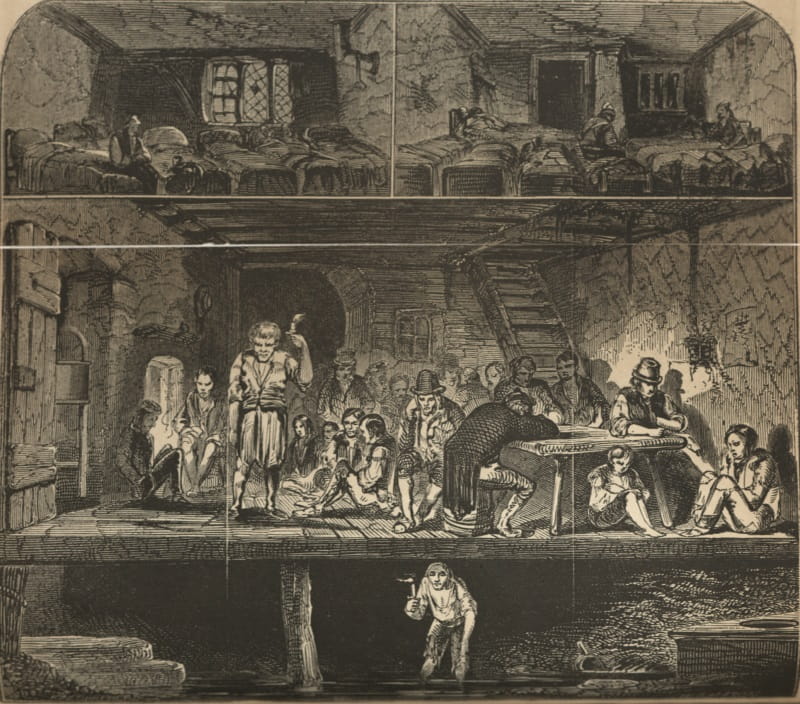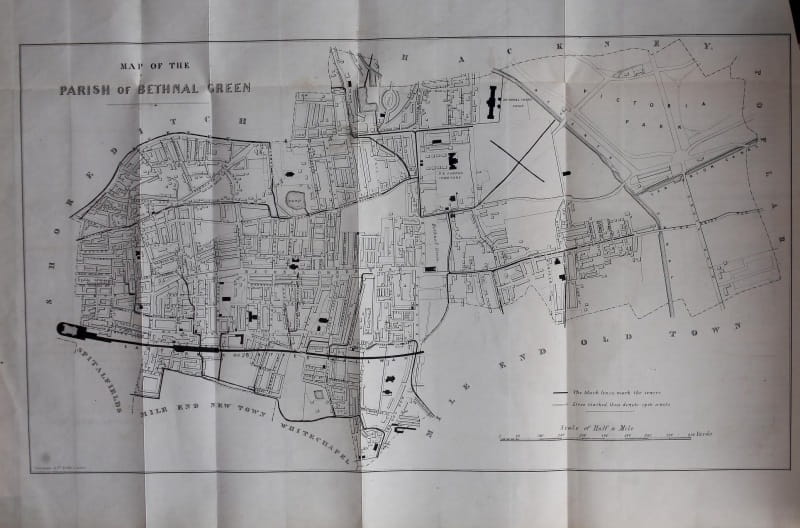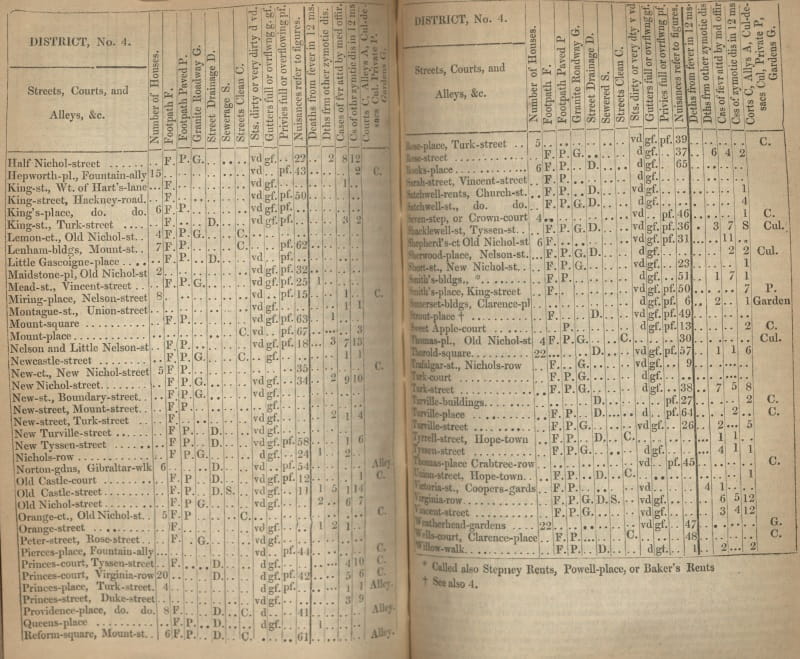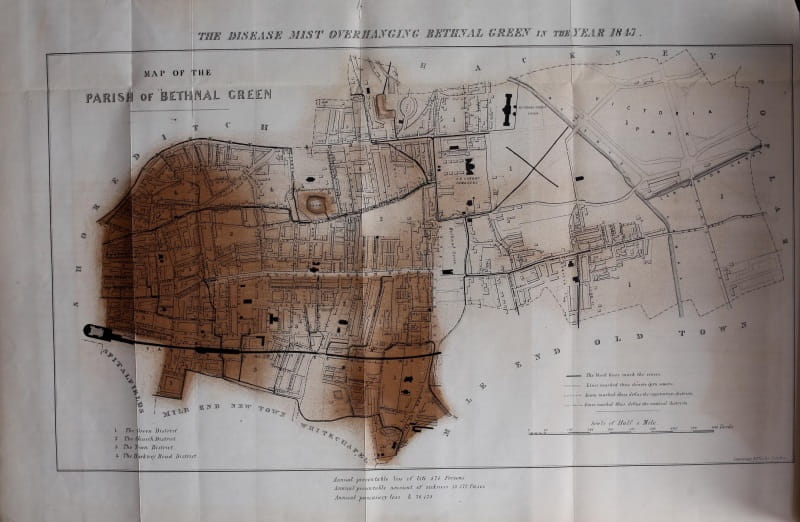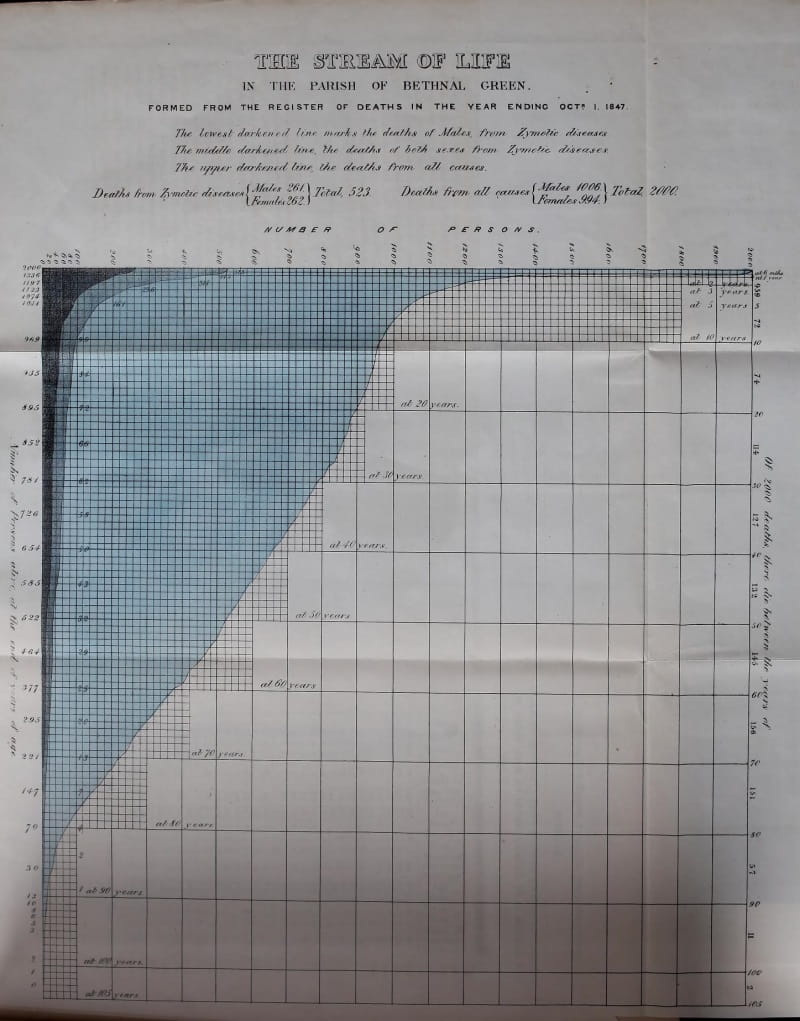Sanitary Ramblings: being sketches and illustrations, of Bethnal Green, a type of the condition of the Metropolis and other large towns by Hector Gavin, 1848
07 Sep 2023
Susan Isaac
Sanitary Ramblings is a graphic description of the dreadful living conditions for many of the residents of Bethnal Green in 1848, written by Hector Gavin (1815 – 1855), a Scottish physician. Gavin details the environments people lived in, street by street and how these situations are reflected in their health and mortality.
Woodcut of a lodging house.
In the 18th century, Bethnal Green was a pleasant country retreat on the outskirts of London and was well-known for its market gardens. Huguenot refugees had created a flourishing silk-weaving industry in the area, but by the 19th century, this was in decline due to competition from abroad and mechanisation. New occupations emerged to replace silk weaving, such as tailoring, furniture making, costermongers (selling fruit and vegetables from carts), and various trades related to the docks and building work. These jobs were low-paid, insecure and often involved long work hours for low wages in dank and depressing surroundings.
By the mid-19th century, Bethnal Green had over 90,000 inhabitants and was regarded as one of the poorest parishes in London. New housing was rapidly constructed to support the growing population but was often built on undrained land and former ponds, leading to damp dwellings. People lived in overcrowded houses without proper sanitation. Human waste and rubbish piled up in courtyards to overflow from basement cesspits into the gutters and surrounding areas. In such conditions, multiple diseases were inevitable. Outbreaks of diseases such as typhoid and scarlet fever were common, but the arrival of cholera led to new investigations into sanitation and the causes of disease.
Map of Bethnal Green.
It was in this atmosphere that Gavin wrote his report. The parish of Bethnal Green had an area of just under two square miles, of which approximately a third was open space. The area was divided into five districts which Gavin explores in turn. He briefly outlines each district’s environment and infrastructure before describing his personal experience of individual streets. The entries about the streets vary from short sentences giving a vivid summary to long paragraphs providing more detail about a number of different aspects of the environment.
In District 1, he describes Park Street as very dirty, covered with mud heaps and refuse; North Place, Green Street is also dirty, but pig styes add to the filthiness and foulness of the effluvia. Whooping cough and measles abound. However, Bernham Square has scattered buildings in gardens and is a remarkable exception in the area being “tolerably clean”.
Harrold Street, Green Street, 26. – In No. 10 in this street, I found eight persons who live and sleep in one room. The room is 10 feet by 6 feet and 9 feet high. The bed and furniture filled no inconsiderable portion of the room; the children had low fever. The house contains two rooms on the ground floor and a workroom above; another family occupied the other room. For the one room, and use of part of the workroom, 2s. 9d. a week are paid. At the corner of this place is a large open brick field.
While in District 4, the roadway for New Nichol Street is described as “in a most dilapidated condition and most disgusting, from the surface being covered with refuse, garbage, mud &…”. At Thomas Place, Old Nicol Street, the privies are close to the houses, and the smell is offensive.
Willow Walk, there is one stand-tap to four houses in the court but there is no receptacle for refuse; there is a cow shed in it. The houses are two-roomed, and all let at 3s a week. None of the inhabitants earn 10s a week.
The sections on each District are followed by tables where Gavin lists the streets he visited and maps their significant features with a key: Footpath (F.). Footpath Paved (P.). Granite Roadway (G.) Street Drainage (D.) Sewerage (S.). Streets Clean (C.). Streets dirty or very dirty (d. or vd.). Gutters full or overflowing (g.f.). Privies full or overflowing (p.f.). Nuisances (N.).
Table for District, No. 4.
The second half of the report summarises the infrastructure he finds in Bethnal Green. He covers everything from accommodation available, how much space is available inside and out, how homes are warmed, ventilated and cleaned, privies, cesspools and sewerage, how the streets are paved and cleaned, the water supply, how dead bodies are dealt with and finally, the sickness, disease and mortality found in the area.
He considers the space different types of accommodation have. If there are gardens or yards to the front and/or back of a house and the impact this has on the potential comfort of the inhabitants. He notes that it is rare to find areas set aside for coal or dustbins and that cupboards and closets are almost unknown, as are sinks and that fire-places rarely placed conveniently for use by the residents.
At this time, only 9% of streets and courts in Bethnal Green were listed as having sewers, although the 1848 Public Health Act had made house drainage into sewers compulsory. In consequence, where houses did have drains, these emptied into cesspits. Those without drains threw their waste into the yard or the street. Surface drains would become choked with waste of all descriptions, overflowing and filthy, making some of the streets almost impassable at times.
Household refuse wasn’t regularly removed by bin men leading to the contents of refuse heaps spreading over the yards and streets. These heaps contained rubbish, ashes, dirt, decomposing vegetables, often animal dung and sometimes putrescent animal remains. Gavin records the comment of one inhabitant in Half Nichol Street “the people never die here, they are murdered by the fever”. It isn’t hard to imagine how this increased the need for street cleaning.
Gavin was appalled by the state of the privies and cesspools found in Bethnal Green. Privies were scarce, generally filthy and often public; they also regularly overflowed. The cesspits weren’t any better, with the contents rarely removed due to difficulty, general unpleasantness and expense. The fluid from the cess pits oozed into the surrounding soil, contaminating drinking sources and eating into wooden floors where housing lacked foundations. Gavin relates a horrifying story of a landlady in Armstrong Building who fell into a cesspool due to the dilapidated condition of the place and was suffocated.
Water was mostly supplied to households via a stand pipe in the street or a yard. One stand pipe might supply anything between 8 or even 30 houses, but that still left people who didn’t have a regular water supply. Water had to be collected in some kind of container and then stored somehow within the home. Water supplies could be intermittent, and not all standpipes could be turned off by a tap. This meant that when the water started to run, it would just run over the street. This could have the effect of cleaning an area, but it could also make rooms in nearby houses damp. Unsurprisingly, waterborne diseases were common.
Gavin finishes Sanitary Ramblings with thirteen tables covering mortality, fever, and other factors, as well as a Disease Mist lithograph and a Stream of Life graph using data taken from the Register of Deaths, 1847. Gavin describes the Disease Mist overhanging the area as an “Angel of death” breathing pestilence and causing death. In the 19th century, it was believed that disease was transmitted and spread by “bad air” or “bad smells” from rotting organic matter. This thinking dominated official medical and government statements. It would not be until 1854 that John Snow (1813-1858) demonstrated a link between cholera and contaminated drinking water rather than breathing in foul air.
“The disease mist overhanging Bethnal Green in the year 1847.”
“The Stream of Life in the Parish of Bethnal Green.”
Sadly despite the woeful state of sanitation in the areas described, Hector Gavin’s report produced little change. In the 1860s, philanthropists like Angela Burdett-Coutts and George Peabody started building tenement housing for the poor, and by 1900 work was underway to eliminate some of the worst slum housing. Later, many areas of the East End, including Bethnal Green, suffered badly from bombing raids during World War 2. Post-war clearance of the slums and bomb sites broke up long-established neighbourhoods, and now Bethnal Green has a mix of housing that dates from every decade since the late 19th century with surviving Victorian terraces and modern tower blocks.
Gavin studied medicine at the University of Edinburgh, specialising in military surgery, before moving to London in 1836. He worked at the London Orphan Asylum, the British Penitent Female Refuge, and the Bethnal Green Workhouse. He also lectured in forensic medicine and public hygiene at Charing Cross Hospital during this time. He was the editor of the Journal of Public Health and the author of several publications. During the 1849 cholera epidemic, he was employed as medical superintending inspector under the General Board of Health and was appointed as physician to the Post Office during the 1854 epidemic. He was also appointed as one of the Sanitary Commissioner’s to the Army in the Crimea to improve sanitation in the war hospitals.
A sad postscript to this life of important pioneering sanitation research and the dissemination of the new understanding was his death. He arrived in the Crimea in March 1855, sharing a tent with his brother, William Gavin of the 17th Lancers, a veterinary surgeon. On 21 April 1855, Gavin died in a tragic accident. He was shot with his own service revolver as he handed it to his brother, grip-first, and his brother caught the trigger, firing into Hector's body.
The Library collection holds many items relating to public health and sanitation covering cities and towns across the country and abroad. They provide a fascinating snapshot of how some people lived in the past. Unfortunately, the copy of Sanitary Ramblings in the Library collection is very fragile and tightly bound, but if you would like to read the report, the Wellcome Institute has a digitised copy.
Susan Isaac, Customer Service Manager

